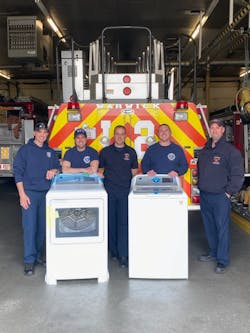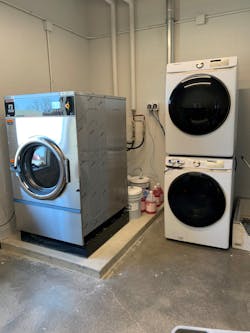Hot Picks: Clothes Washers & Dryers
It’s a simple truth: No fire department can succeed at ensuring the well-being of its personnel without using all of the tools that are at its disposal.
Among the essential components to maintaining a healthy environment for members at the firehouse are the humble washing machine and dryer. Laundry appliances might get overlooked as part of a department’s arsenal, but they shouldn’t be, Scott Csendes of architectural firm KZF Design says. Csendes, who is the director of KZF’s Civic & Public Safety Group, states, “We’re spending a lot of time regarding washers and dryers. When you are planning a new fire station, you have to pull together all the systems. If they are not configured, you are defeating the purpose,” and that includes laundry appliances, he tells Firehouse Magazine.
Station zones & laundry
Stations work best when Hot, Warm and Cold Zones are designated. Of course, the configurations vary according to a department’s size and space, but there are common themes: Hot Zones are those that have the most exposure to contaminants—where turnout gear and apparatus are kept. It’s where members leave their turnout gear to be cleaned in extractors and drying closets. Members then move to a Warm Zone, and the clothes that they had on under the turnout gear are put into the same kinds of washing machines and dryers that are marketed to civilians. After showering and putting on fresh clothes, members move to the living quarters and administrative areas. Another set of washing machines and dryers in this Cold Zone take care of uniforms that are worn at the station and bedding.
Chief Mike Passarelli of the Tallmadge, OH, Fire Department is a three-time cancer survivor. He is passionate about reducing carcinogens, including in the firehouse. His department will open a new Station 2 in July 2022, and the department purchased a large-capacity washer for the new station.
“Prostate cancer is recognized in Ohio as predisposition for workers’ compensation,” Passarelli explains. “It’s presumed you got it on the job.” (According to research that was conducted by Firefighter Cancer Support Network, firefighters have a 1.28 times greater risk of being diagnosed with prostate cancer than the general U.S. population.)
“I have a passion to do this for the guys coming after me,” Passarelli says. “I cannot emphasize the importance of this more.”
The Lebanon, OH, Fire Division was in the process of completing the construction of the first purpose-built station in the department’s history as this article went to press. The new station sports a 19,000-square-foot decontamination area that’s located in the apparatus bay that has a commercial front-load washing machine and dryer. Another washer and dryer are in the living quarters, strictly for uniforms.
Steve Johnson, who is the chief of department, says that Lebanon used government money that was made available to first responders at the onset of the pandemic to purchase two sets of washing machines and dryers for the new firehouse and one set for the department’s other firehouse. The new firehouse will service seven full-time and five part-time personnel on any given day.
“We typically see clients either purchase larger units or run more staggered loads to avoid the need for more pairs of washers/dryers in firehouses with larger personnel counts,” Csendes tells Firehouse Magazine.
Passarelli agrees. “Think five or six members. You don’t need multiple washers and dryers [in any one zone]. Just do another load.”
In addition to carcinogens from fires, potential contaminants span a variety of bad things, such as particulates and fluids that are picked up from chemical runs, Csendes says.
“Bedbugs, COVID, whatever,” Lebanon Fire Division’s Johnson adds.
Csendes believes that washing machines that are placed in a Warm Zone should have a capacity of at least four cubic feet.
Rashmitha Matta of Electrolux says that washing machines and dryers that have
4.5 cubic feet of capacity can handle the laundering of a king-size comforter.
GE Appliances’ Allison Martin pegged large-capacity washing machines as those that are “closer to five cubic feet.”
Discounted opportunities
Martin is GE Appliances’ senior director of corporate citizenship. She oversees the manufacturer’s donation of washing machines and dryers to firehouses, which started in March 2020. The program, which is called GEA4Heroes, has facilitated the donation of appliances to two dozen firehouses thus far as well as to some individual first responders.
“When we donate [laundry appliances], each firehouse has different requirements,” Martin says.
Donations to FDNY fire stations took into account space limitations, which meant stackable models.
GE Appliances also has a discount program for firehouses, as do other appliance manufacturers and large retailers.
Eloise Hale of Electrolux says her company provides discounts for washing machines and dryers through the Electrolux Friends and Family Store ([email protected]).
Samsung’s website offers a discount of as much as 30 percent on select models of washers and dryers for firefighters and paramedics. Included among the models for which a discount can be applied are washing machines and dryers that have a steam mode, which is a function that might be of particular interest to fire departments. (See “Key Features for Firehouse Laundry Appliances.”)
Key Features for Firehouse Laundry Appliances
Cean Burgeson, who is a spokesperson for Whirlpool, suggests that firehouses should use commercial-grade, single-load appliances because of their inclusion of drive systems that are more powerful than those that are incorporated into consumer models. These also have “commercial-grade” parts.
Alliance Laundry Systems, which manufactures Speed Queen commercial laundry appliances, says that its commercial-grade parts are made of metal instead of plastic.
That said, we aren’t convinced that commercial models are necessary for the majority of fire departments, particularly those whose membership is on the smaller side. Furthermore, Electrolux’s Rashmitha Matta says that, although commercial models are more robust, they are rougher on clothes, and we found that the capacity of many consumer washing machines and dryers are greater than that of typical commercial models, while prices of the former are lower than that of commercial models in a significant majority of cases.
Major manufacturers all offer appliances that have sanitize options. These might be identified by different names, but they all aim to eliminate 99.5 percent of bacteria by subjecting clothes to high temperatures. How high isn’t always disclosed—Electrolux says the temperature is proprietary information—but Wash.com says that “high-temperature” means at least 130 degrees Fahrenheit. The temperature of drying cycles in GE Appliances’ GE dryers can exceed 150 degrees Fahrenheit. The company tells Firehouse Magazine that 60 percent of its washing machines and dryers have the sanitize feature.
Higher temperatures also can be achieved by models that have a steam option. According to HouseLogic.com, washing machines that have a steam option boost the temperature that’s inside of the washer drum. This causes fibers to absorb water and helps detergent to dissolve quickly to kill bacteria more efficiently.
Models that have steam options have been around for 20 years and have come down in price, although the majority are at least $200 more expensive than models that lack a steam option.
Hot Picks: Laundry Appliances
Firehouse Magazine’s “Hot Picks” clothes washers and dryers are listed with their manufacturer’s suggested retail price (MSRP). Often, the price that you will find for an appliance at a retailer will be different than the MSRP, including, perhaps, 1 percent–5 percent less.
Washing machines that are promoted to be high-efficiency (HE) tend to include features/functions/components that permit them to consume less water and energy per load of laundry compared with models that lack HE technology. HE models can use as much as 80 percent less water than traditional top-load washers, can deliver as much as 65 percent energy savings and can wash more laundry per load than traditional machines.
Front-load washing machines typically have a smaller capacity than do top-load models.
WASHING MACHINES
HIGH-EFFICIENCY TOP-LOAD
LG WT7800CW
The WT7800CW’s capacity is larger than that of any other model in our HE universe, yet its MSRP is less by $100 than the model that has the next-largest capacity. The WT7800CW has a stainless-steel drum, which is more rugged than models that have coated steel or plastic drums. This model provides a steam option for deeper cleaning, which some more expensive models lack. This model’s TurboWash3D is said to complete a wash cycle in 29 minutes.
- MSRP: $899
- Steam: Yes
- Stainless steel drum: Yes
- Capacity: 5.5 cubic feet
TOP-LOAD
Samsung WA51A5505AW
Only a model that has an MSRP that’s $255 more than this model’s MSRP has more capacity than the WA51A5505AW, and you get only 0.1 cubic feet more space from the more expensive unit. This model’s Super Speed Wash is said to complete a wash cycle in 28 minutes. Unfortunately, this washer lacks a high-temperature, steam or sanitize mode, but that’s typical of this segment.
- MSRP: $749
- Steam: No
- Stainless steel drum: Yes
- Capacity: 5.1 cubic feet
FRONT-LOAD
Samsung WF45R6100AW
The WF45R6100AW has a steam option—and at the lowest MSRP (by $200) of any model that we found in this segment. Nevertheless, its capacity is the same as the more expensive unit. The front-load washing machine that has a larger capacity (by only 0.3 cubic feet) has an MSRP that’s $300 more. Of importance for firehouses where space is at a premium, the WF45R6100AW permits a stackable configuration. That said, the matching electric dryer (DVE45R6100W) and matching gas dryer (DVG45R6100W) weren’t selected as Hot Picks.
- MSRP: $749
- Steam: Yes
- Stainless steel drum: Yes
- Capacity: 4.5 cubic feet
Dryers
Samsung DVE50A8600E
The DVE50A8600E electric dryer has both a steam option and a stainless steel drum. Its MSRP is $400 less than the MSRP of the next model that we found that has those features, and its capacity is 0.1 cubic feet larger than the more expensive unit. The unit is stackable, but its matching washing machine wasn’t selected as a Hot Pick. A gas version of the dryer (DVGA8600E) is available ($1,099).
- MSRP: $999
- Stainless steel drum: Yes
- Steam option: Yes
- Capacity: 7.5 cubic feet
Tom Williams
Tom Williams has been an editor and reporter for 40 years, including nine years as a senior editor at a leading consumer magazine that delved into product performance and value. In that role, he oversaw and wrote articles on appliances, power tools and similar goods and evaluated products.









